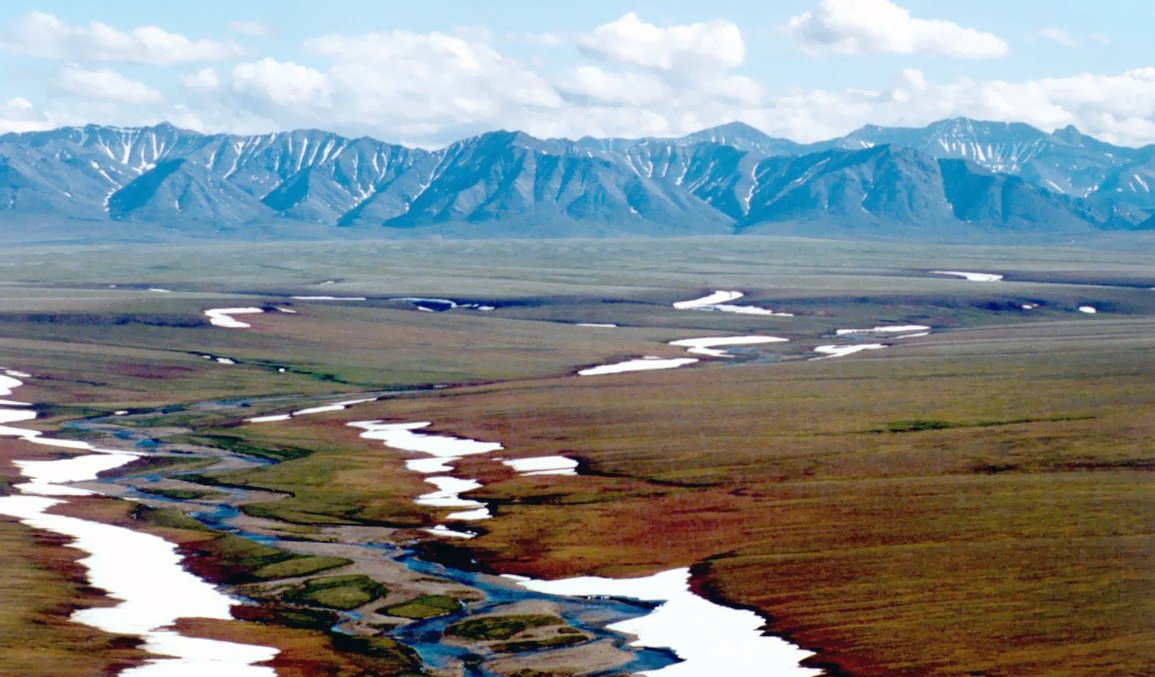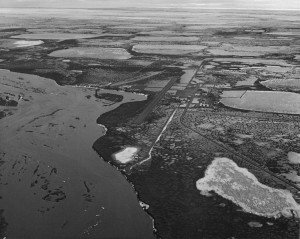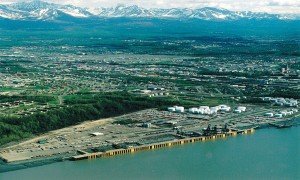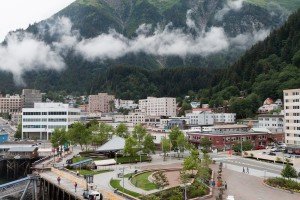The Arctic Melt: Turning Resource Development Into Human Development (Part II)

Area of the Arctic National Wildlife Refuge coastal plain, looking south toward the Brooks Range mountains. Photo: US Fish and Wildlife Service
The Arctic Melt is a three-part analysis of the Arctic Human Development Report II: Regional Processes and Global Linkages. Developed over a ten-year period, the study assesses the state of Arctic human development and highlights major regional changes. Its findings will be important in informing the decisions and policies of the upcoming US Arctic Council Chairmanship.
In the context of Alaska, this series will take an in-depth look at three of the key trends underscored by the Report: globalization, urbanization, and demographic shifts. On Monday, Part I: Investing in Place will explore how we create livable, localized places in a globalized north. On Wednesday, Part II: Investing in Innovation will consider the opportunities of urbanization for entrepreneurship and economic ingenuity. On Friday, Part III: Investing in Communities will conclude the discussion by looking at ways to sustainably connect the growing young and old sectors of Alaska’s population.
Taken together, these three trends provide a chance to redefine how we conceptualize, and realize, Arctic investment – a chance to turn economic growth into human development.
Part II: Investing In Innovation
Last month, President Obama announced that he would ask Congress to ban drilling on 12 million acres of the Arctic National Wildlife Refuge in Alaska.1) While environmentalists applauded his efforts, the ban was met with fierce opposition from a number of politicians. Alaskan Senator Lisa Murkowski called it “a stunning attack on our sovereignty and our ability to develop a strong economy that allows us, our children and our grandchildren to thrive.”2)
Despite such outcries, President Obama’s proposal to explore options for economic development beyond oil drilling may be protecting Alaska’s economy as much as its environment.
The second Arctic Human Development Report, released last week, concludes that prohibitively high costs of doing business in the north will persist long into the 21st Century in spite of high expectations for a climate-induced resource rush.3) The net costs of climate change, combined with the volatility of commodity prices, will continue to push investments down in Alaska’s already declining petroleum production.
Major commercial conditions such as an uncertain future for Arctic oil is important to northern human development, as economic activities define the material well being of the region’s residents. With the prospects of expanding petroleum markets proving overly optimistic, President Obama’s drilling ban provides an opportunity to move Alaska’s economy beyond that of extractive industries and towards investing in human development through a knowledge economy with significant investment in human development..
Restructuring the state’s economy from resource-focused to human-centered means investing in institutional and physical infrastructure that will best serve current and future Alaskans. Architects of a new economic framework must be conscious of Alaska’s development history, able to build within the major overarching trends of change today, and mindful of the Arctic climate’s future shifts. Informed by an understanding of its past, present, and projected future, Alaska has the tools to make sound, sustainable economic decisions and the means to redirect investment towards local innovation.
The Arctic, an Economic History
Ten years ago, the first Arctic Human Development Report noted that the circumpolar north was a natural resource reservoir that could quench the world’s energy and mineral appetite. It also highlighted the trend in Alaskan history of petroleum dominating both economic activity and state investment, thought it noted that there was a recent reduction in the role of government and federal subsidies to support extractive activities.4) While the report touched on the beginnings of privatization and diversification of the local economy, citing new power in companies and new activities like tourism as major changes, the first report’s economic analysis in 2004 relied substantially on evaluating resource markets and effects.
Today, both of those original statements, the Arctic as an energy reserve and as a resource-dominated economy, still hold true. A recent USGS survey estimates that the Arctic holds almost a quarter of the world’s undiscovered conventional oil and gas.5) Unsurprisingly, Alaska’s economy is still deeply entrenched in its extractive legacies. The intermediary decade between the first and second Human Development Report saw the invention of a number of new technologies and processes to increase oil production, resulting in a dramatic expansion in the Arctic regional economy. Between 2000 and 2010, the Arctic’s regional growth far exceeded that of the eight individual Arctic nations. Its economic output, 0.6 percent of world GDP, was four times its share of the population, and at 442.8 Billion USD, the Arctic Gross Regional Product was equal to the entire national economies of Malaysia and Columbia in 2010.6)
Some financial forecasters, particularly those cited by mass media outlets, are optimistic that high growth rates will climb even higher from the economic benefits of climate change. Throughout its globalized modern history, the biggest challenges of doing business in the Arctic have always been the region’s harsh climate and the remoteness of resource deposits from centers of consumption, production, and decision-making. The price of researching and developing cold-weather equipment and the increased costs of shipping out products and bringing in material, labor, and other resources to production sites all add to the high cost and debatable viability of doing business in the high north when compared with more temperate sites.
Climate change has the potential to change those environmental conditions once thought of as fixed. Warmer air and water are prolonging the ice-free travel period in Arctic seas, improving access and lowering costs of delivering supplies and bringing products to international markets. Warmer temperatures also mean that there is a reduced need to invest new technologies to withstand extreme conditions.
Despite optimistic business reports and news stories based on a resource rush narrative, climate change is a net cost to both those who live in and those who extract resources from the Arctic.7) The future of an ecologically changing Arctic is uncertain. Increasing storm surges, shoreline erosion, and thawing permafrost are all challenges to existing and forthcoming industry infrastructure.
But perhaps more worrisome than the impacts of climate change is Alaska’s challenge of a maturing resource economy as petroleum production is in decline. Oil production in Alaska peaked more than two decades ago, and although new fields and new production technology have slowed the decline production continues to fall.8) With new unconventional and shale reserves being tapped in more environmentally hospitable places like North Dakota and southern Canada, world energy demands can be met without drilling in America’s circumpolar north.
Oil revenue has significantly contributed to Alaska’s revenues, employment rate, and ability to provide welfare services from taxes since the onset of its production at Prudhoe Bay in 1977. Today it accounts for ninety percent of the state’s revenue, and it is estimated that direct activity in the oil industry and the effects of the state’s spending on oil account for one-third of Alaskan jobs.9)
Reliance on oil for financial and human well being pose a major challenge for Alaska, but also an opportunity to rethink how it invests for an economically sustainable future. Although a number of state savings funds, of which Alaska’s Permanent Fund is the largest, will soften the effects of the petroleum decline, Alaska needs a new, more resilient economy for the 21st Century. Other natural resource industries in the state are too small to fill the gap left by petroleum – giving Alaska the chance to think beyond resource-generated wellbeing.
Globalization and Urbanization: A Framework for Innovative Growth
A new economic structure must be built in the context of the major, overarching trends identified by the Arctic Human Development Report – namely globalization and urbanization. Taken together, globalization and urbanization in Alaska provide not just the context for redefining investment; each trend provides valuable conditions to foster an economy built on sustainable innovation and resilient entrepreneurship.
Part I of this series explored the challenges and opportunities of globalization for Alaskan physical infrastructure investment, focusing on the use of smart growth principles to invest in place. Similar changes spurred by globalization also help to create an ideal environment for an innovative economy. The decentralization of political power and the increased local control and ownership of local economic resources allow more opportunities for officials to work with local stakeholders and choose investment in innovation over extraction. Globalization has also provided important access to global communication and information sharing systems, making it easier for small business to access international markets and for entrepreneurs to exchange best practices to support local development.
Investing in place through smart growth, as advocated in Part I, helps to create an ideal built environment for creating a knowledge economy and fostering economic prosperity. By planning and building smarter, municipalities can reduce the cost of water and energy infrastructure and that of transportation maintenance. Smart growth is also proven to benefit household budgets by increasing property values, reducing transportation costs, and building affordable places to live that are interdependent parts of a strong, regional economy. Local business that are an integral part of the overall regional economy likewise benefit from Complete Streets. Investing in walkable downtowns and robust public transportation systems increases foot travel for local buyers and helps attract and maintain talented, long-term workers.10)
As most smart growth occurs in cities, it is conducive that urbanization in the Arctic is rapidly accelerating. Over the past decade, urbanization has had just as an intense an impact on human development as has globalization. Despite the Arctic visual narrative of barren white icescapes, more than half of Alaskan residents now live in cities. Outmigration from rural communities towards more densely populated areas, net flows of immigration to the Arctic, and the emergence of “climigration” have all contributed to not only the magnitude and complexity of urbanization itself, but also the multifaceted challenges to human development in the Arctic.
In 1920, only 6 percent of Alaska’s population resided in urban areas. Today, that number is 66 percent, with 49 percent of all Alaskan Natives living in the five most-populous boroughs. While this is still far below the level of urbanization for the entire country, which currently stands at 82.4 percent, Alaska is unique in that 55 percent of the state population resides in just two cities – Fairbanks and Anchorage.11)
Like globalization, urbanization brings with it important political and social transformations that provide key underpinnings for innovation and entrepreneurship. Globally, economic activity is intensely concentrated in urban areas. While urban areas account for only 2 percent of the earth’s landmass, they are the source of the vast majority of global gross domestic product (GDP). Cities also provide a unique environment for developing adaptive economic growth policy. Unlike national governments, which often split economic policy-making authority among several branches of government, city leaders often have both centralized executive power to act within their jurisdictions and some access to policy instruments needed to foster innovation and business in their cities. City mayors have a variety of economic tools to support creative industries, stimulate investment in local ventures, create a knowledgeable workforce, and ensure workers well being through public services.
In addition, because of more flexible governance structures, city leaders who confront budget and funding constraints, which are all too likely to persist in the coming decades, have the leeway to come up with creative responses. Creativity arises out of the municipal government’s ability to champion change, engage the public more quickly, enact legislation, implement new programs, or create partnerships in shorter time frames and in more targeted ways. By contrast, financing proposals hatched by national governments, even sound ones, can be more easily hampered by politics and require a much longer time frame to build the bipartisan support necessary for passage. Cities, as nodes of opportunity and economic productivity, contain an added layer of diverse cultural capital creation, which is desired by a growing class of skilled workers.
The trends of globalization and urbanization form an ideal frame within which economic innovation can occur. However, in order to use this frame effectively for local economic prosperity, Alaska must nurture and educate a skilled population that can create, share, and use knowledge; build economic and institutional regimes that provide incentives for investing in entrepreneurship; and advance an innovative system of firms, research centers, and other organizations that can facilitate the effective dissemination of best practices, tap into the global supply of knowledge, and adapt it to the Arctic.
Unlocking Entrepreneurship through Soft Infrastructure
A knowledgeable and skilled workforce is the foundation of creating a strong local economy in Alaska. As education is a central pillar for both sustainable economic development and creating a sense of place and community, the last installment of the series, Part III: Investing in Communities, will focus exclusively on education. Part III will bring Parts I and II together through a discussion of integrating schools into a knowledge-based economy and smart neighborhood design.
Beyond educated workers, Alaska must invest in regimes that provide incentives for entrepreneurship and the efficient use of existing and new knowledge. Creating a strong reputation for commitment to investment in research development, creativity, and design is one layer of such a system. This could be achieved through local innovation grants, business tax benefits, and providing funding for fixed capital that benefits a knowledge-based, localized economy instead of infrastructure that support multinational extractive industries.
Alaska must finally create and support institutions that will create, exchange, and communicate new ideas effectively. Firms cluster in cities, creating an agglomeration effect that facilitates the spillover of knowledge between firms within and between sectors and reduces friction in matching labor market supply and demand.12) The cross-pollination of knowledge between sectors translates into more opportunities to build knowledge capital. A result is that more innovation per capita is generated in metropolitan regions. Cities by their very nature provide agglomeration benefits and proximity that caters to the process of invention. Inventors thrive in places that can act as testing grounds for their experiments. Proximity offers a short feedback loop between inventor, competition, the market, and peers, and allows for rapid iteration and improvement.
The existence of Silicon Valley in the San Francisco Bay Area, the Raleigh-Durham-Chapel Hill research triangle in North Carolina, and the start-up technology and university community in Boston-Cambridge in Massachusetts illustrate the agglomeration effect and its positive impact on innovation. In January Norway’s Minister of Foreign Affairs Børge Brende spoke about transforming the Norwegian Arctic into a “mini Silicon Valley.“13) He described a high north where the local economy was driven by invention and entrepreneurial initiative – an economy driven by human capital.
To help make this a reality, Norway has both Innovation Norway, a government initiative to support the development of local business, and Arctic Innovation Group, a team of investors that provide seed money for sustainable and profitable technology companies in Norway’s Arctic.14) Both have helped many small-scale entrepreneurial goods and services reach world markets and have contributed to improving Arctic standards of living. The programs give broad business support, financial provisions, and networking services to small enterprises.
Building the soft infrastructure like Innovation Norway and the Arctic Innovation Group could give urban Alaskans an opportunity to capitalize on their cities’ assets and build their own local entrepreneurial economy. The program could provide strategic assistance and start-up financial support to Alaskans in the production of northern goods and services, partnered with successful American companies across the nation.
Cities also provide an ideal testing ground for new technologies developed there. Electric vehicles are one such technology that benefit from urban testing. Former Los Angeles Mayor Antonio Villaraigosa is aiming to turn his city into the “electric car capital of the world” with 80,000 EVs by 2015.15) Charging stations have become commonplace at airports, businesses, freeway rest stops, and big-city parking garages, which total just over 1,800 statewide, or 21.6 percent of those in use across the United States. Free parking, access to restricted lanes, discounted tolls, and purchase subsidies are all successfully being pursued in cities pushing for more electric vehicle use.
While not as large as Los Angeles’ pilot program, electric vehicles are not only being tested, but are also being adapted by entrepreneurial northerners who are making them efficiently and economically cold-climate friendly. With over half of the state’s population living in Fairbanks and Anchorage, these two urban areas provide an ideal setting to collect necessary baseline data on the local economic and demographic needs and to implement other small-scale programs that adapt successful design from the continental US to the Arctic region. By supporting initiatives to test northern innovation in Alaskan cities, policymakers can help to make a mini Silicon Valley in America’s Arctic too.
A Kick in the Gut to Kickstart Alaska’s Economy
In the European Arctic, natural resource sector industries are responsible for less than twenty percent of economic output. This compares to more than sixty-three percent in the North American Arctic.16) While homegrown innovation drives Nordic economies, the economy of the North American circumpolar region still relies heavily on extractive, multinational industries. Unlike local knowledge based economies that both profit from and create local human capital, large-scale resource production often brings the necessary capital, technological expertise, and labor from outside the region. This means that much of the income generated by resource projects ultimately leaves the local economy, undermining the substrata of human development.
The decline in petroleum production and net costs of climate change provides the chance to sustainably reinvent Alaska’s economy.
Alaska must begin to invest in the commercialization of ideas in preparation for the not so distant future when resources can no longer support the wellbeing of its residents. Taking advantage of the political, economic, and social benefits of urbanization and globalization by investing in hard and soft infrastructure could spur more local economic innovation and augment the non-resource sectors of Alaska’s economy.
But beyond building infrastructure, Alaska’s economy today requires a new way of thinking about the challenges and social needs of a globalized Arctic population. The relationship between the globalized cities in which people live and the economic policies that govern their well being must be rethought to highlight the mutual returns of their connection. The uncertainty of commodity prices, the net cost of climate change to resource development in the north, and the US chairmanship together provide the chance to change how planners and citizens alike think about local infrastructure projects, welfare policies, and the Arctic economy.
In response to President Obama’s wildlife protection proposal, Senator Murkowski pledged that Alaska “will fight back with every resource at our disposal.”17) While the National Wildlife Refuge is projected to hold large petroleum reserves, the new Arctic Human Development Report makes it clear that there will be no 21st Century resource rush for Alaska.
Instead of seeing President Obama as an opponent, Alaska should see him as a partner in using the US Arctic Council Chairmanship to develop a strong, northern economy that capitalizes on urban innovation and local design. By investing in the infrastructure needed to support a non-resource economy – by investing in local innovation instead of extractive industry – Obama’s environmental protection is not “a kick in the gut to Alaska’s economy.” It is an opportunity to rethink northern economic investment to allow Alaska to thrive for generations to come.
References


